4 April, 2000
Dive Clothing
Question 45: What temperature is the sea ice and water in Antarctica?
Today we have swirling snow. The station crew is busily flagging the station
in preparation for winter. Edges of stairs, corners of decks, walkways,
pipes, holes all get six-foot bamboo poles topped with a yellow flag attached
to them. Anything you do not want to lose, fall into, or drive over gets
marked. I tended a shore dive in Hero Inlet, but even in that protected area
there was lots of surge. The divers really got knocked around near the
surface.
The clothes and suits we wear diving help keep us warm (and also provide
quite a bit of padding) in the cold water. We start out with a regular set of
polypropylene long underwear and socks to wick away any moisture. Not
moisture from the suit leaking--that would be too much for wicking to deal
with, but from us sweating as we put all of the gear on. Then we put on a
special suit of underwear and booties made especially for diving with dry
suits. It is made of a thick layer of thinsulate. It is a very compressed
material so the insulation value doesn't depend on large air pockets (as with
down or fleece) which would be squished and worthless while diving. The
increased pressure experienced by divers underwater affects how we dive as
well as the gear and clothing we wear.
Next the dry suit itself goes on. In slightly warmer areas, many divers use
wet suits. Wet suits are made of heavy neoprene that gets wet inside but fits
snugly so that it keeps water from circulating. The warm water is held near
the skin so that the diver's body doesn't get cold by continuing to heat a
never-ending supply of cold water. In a dry suit, the diver stays completely
dry thanks to latex rubber seals at the neck and wrists. The dry suit is made
of tough vulcanized and synthetic rubber.
We enter the dry suit through a waterproof zipper that goes across the
shoulders. Every seal on a dry suit is a potential source of leakage so we
want as few openings as possible in the suit. These dry suits have boots that
are part of the suit itself. The only other openings besides the zipper are
two valves (power inflate and exhaust) and the neck and wrist seals. The
seals have to fit tightly (to the point of discomfort) to keep water out
effectively.
We step into the dry suit like a pair of pants; there are suspenders at the
waist to help hold the suit on properly. Then our arms go in and we adjust
the wrist seals on the inside of the wrists. Last of all, we put our head
through the neck seal and hope our ears don't get pulled off. The neck and
wrist seals are relatively easy to tear so divers never wear any jewelry or
hair clips when putting the suit on. Seals can sit flat against skin or can
be turned under (something we do when the seal is looser than we like--air
pushing from inside the suit makes a tighter seal). When a dive buddy or
tender zips up the suit, they make sure that nothing gets caught in the
zipper. It only takes one little piece of underwear in the zipper to flood
the whole suit.
To keep our hands warm and dry we wear dry gloves. The suits have wrist
rings with grooves that special rubber gloves snap over to seal out water.
Each diver wears slightly different gloves underneath for warmth. I wear a
pair made of medium-weight fleece. To allow the air inside the gloves to
equalize while diving, we put small tubes in the wrist seals that connect the
hand space with the arm space. These dry suits also have attached "dry"
hoods. They do let water leak in, so most of us wear a thick wet-suit hood as
well/instead to keep our head warm.
Besides wearing all of this clothing to keep us warm and dry, we also need to
be able to see and move underwater. The mask that allows us to see seals to
the face around the eyes and nose. It is a little tricky to get the mask
strap over the hood and the seal inside the hood on the face. Because of the
temperature difference between face and water, masks tend to fog up unless we
rub a soapy anti-fogging solution or spit on them before the dive. The only
way to defog a mask underwater is to let some water leak in and swish it
around. Our fins have large foot pockets to accommodate the dry suit boots.
In diving, the power gained from kicking with fins eliminates the need to use
hands and arms to move through the water. It frees them up to carry equipment
or gather things.
Answer 44: Fresh water. Icebergs originate from snow that falls on
Antarctica. The weight of the accumulated snow squeezes the crystals into
ice, and the ice flows slowly down to the sea. When it reaches the water, it
breaks off or floats out as part of an ice shelf before eventually breaking
off.

Dry suit long underwear.
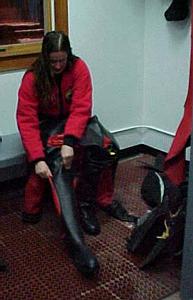
Pulling on the legs of the dry suit.

Dry suit half on.
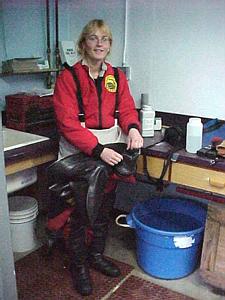
Suspenders up.
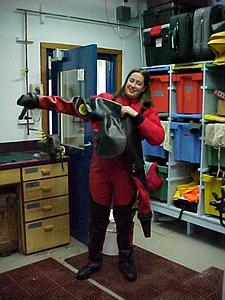
Putting on the arms of the dry suit.
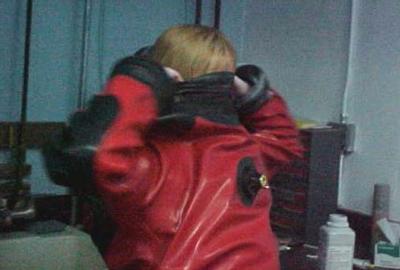
Pushing and pulling head through the dry suit neck seal and hood.

Zipping up the dry suit.
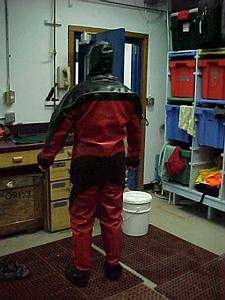
Back view of the diver in a dry suit.
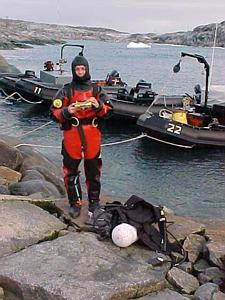
Katrin Iken in dry suit and weight harness preparing to put on mask.

Dock, loading area, and storage vans flagged for winter.

Wrist seal with dry glove ring and equalizing tube.

Contact the TEA in the field at
.
If you cannot connect through your browser, copy the
TEA's e-mail address in the "To:" line of
your favorite e-mail package.
|
